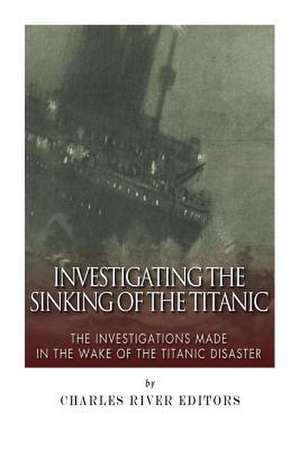Investigating the Sinking of the Titanic
Autor Charles River Editorsen Limba Engleză Paperback
*Includes passengers' accounts and testimony from the investigations
*Explains the different investigations' findings and the changes made
*Includes a bibliography for further reading
Just before midnight on April 14, 1912, the RMS Titanic, the largest ship in the world, hit an iceberg, setting in motion a chain of events that would ultimately make it history's most famous, and notorious, ship. In the over 100 years since it sank on its maiden voyage, the Titanic has been the subject of endless fascination, as evidenced by the efforts to find its final resting spot, the museums full of its objects, and the countless books, documentaries, and movies made about the doomed ocean liner. Thanks to the dramatization of the Titanic's sinking and the undying interest in the story, millions of people are familiar with various aspects of the ship's demise, and the nearly 1,500 people who died in the North Atlantic in the early morning hours of April 15, 1912. The sinking of the ship is still nearly as controversial now as it was over 100 years ago, and the drama is just as compelling.
The Titanic was neither the first nor last big ship to sink, so it's clear that much of its appeal stems from the nature of ship itself. Indeed, the Titanic stands out not just for its end but for its beginning, specifically the fact that it was the most luxurious passenger ship ever built at the time. In addition to the time it took to come up with the design, the giant ship took a full three years to build, and no effort or cost was spared to outfit the Titanic in the most lavish ways. Given that the Titanic was over 100 feet tall, nearly 900 feet long, and over 90 feet wide, it's obvious that those who built her and provided all of its famous amenities had plenty of work to do. The massive ship was carrying thousands of passengers and crew members, each with their own experiences on board, and the various amenities offered among the different classes of passengers ensured that life on some decks of the ship was quite different than life on others.
Much has been made through the years about the failures of those designing the Titanic to take proper safety precautions, and how these failings led to the disaster and huge loss of life. In fact, the number of lives lost was so great that it can be hard to believe that the death toll might have been higher. Nonetheless, it's true that many more would have died without the courageous efforts of those on the ships who responded to the Titanic's distress calls and sailed through the same dangerous conditions that brought down the "unsinkable" ship itself.
The drama involved with the sinking of the Titanic often obscures the important aftermath of the disaster, particularly the several investigations conducted on both sides of the Atlantic that sought to figure out not only why the Titanic sank but future changes that could be made in order to protect ships and passengers in the future. In fact, the course of the investigations was interesting in itself, especially since the British and Americans reached wildly different conclusions about what went wrong and led to the ship's demise.
Investigating the Sinking of the Titanic chronicles the immediate aftermath of the tragedy and the investigations and changes that followed. Along with pictures of important people, places, and events, you will learn about the investigations like never before.
Preț: 47.65 lei
Nou
9.12€ • 9.52$ • 7.55£
Carte disponibilă
Livrare economică 14-28 martie
Specificații
ISBN-10: 1502432277
Pagini: 70
Dimensiuni: 152 x 229 x 4 mm
Greutate: 0.1 kg
Editura: CREATESPACE
